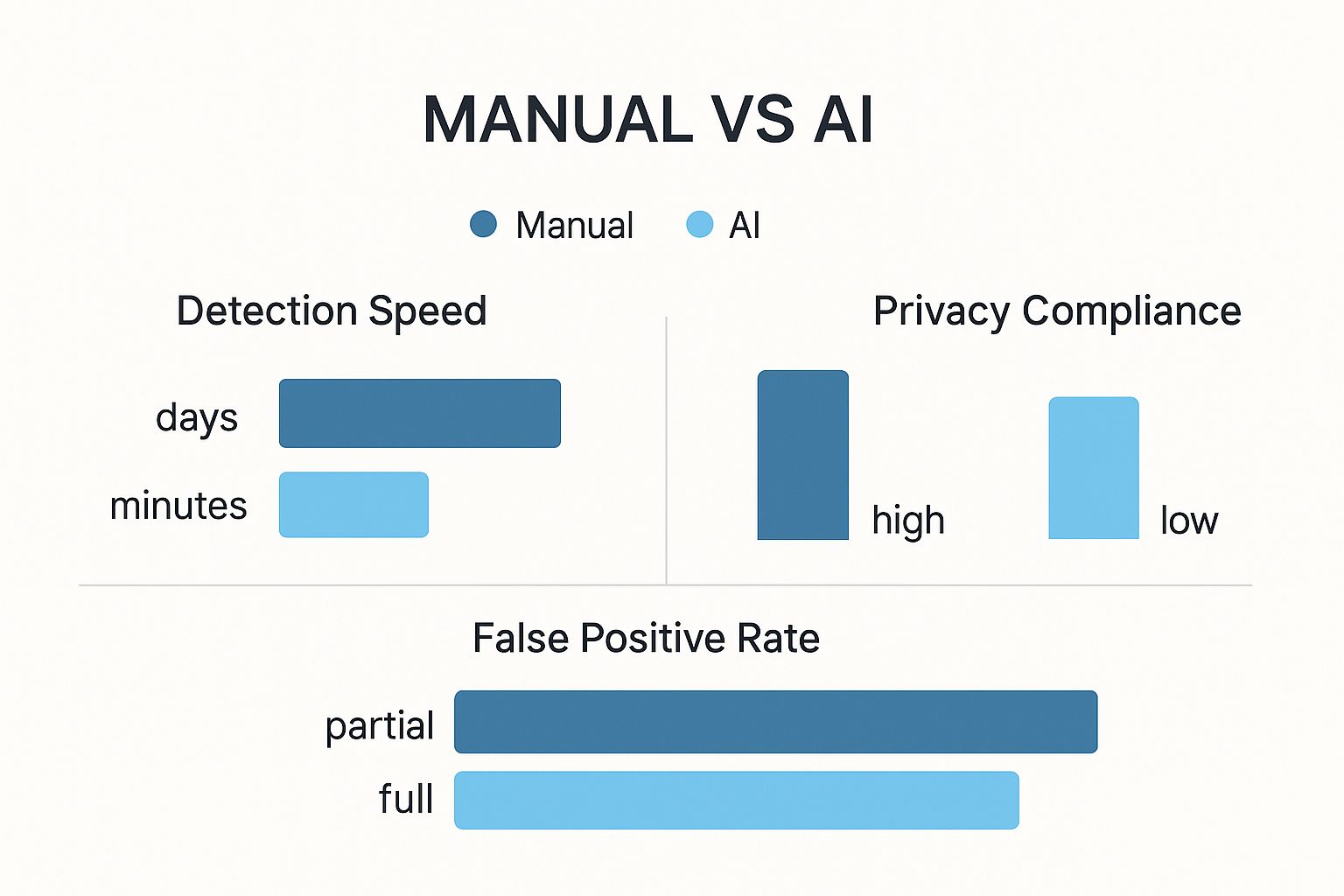A Guide to AI-Powered Human Risk Management and internal threats prevention
- Marketing Team

- Oct 16
- 13 min read
Human risk management and internal threats prevention is the critical process of identifying, assessing, and mitigating risks originating from people—their actions, behaviors, and decisions. In today's complex business landscape, where a single human error can lead to significant financial loss or reputational damage, a reactive approach is no longer sufficient. Organizations need proactive, intelligent solutions. This is where Logical Commander's ethical AI platform transforms your biggest blind spot into your most resilient defense, ensuring integrity and compliance without compromising human dignity.
The Unseen Threat of Human Risk and internal threats prevention

Most companies invest heavily in technical fortresses—firewalls, antivirus software, and network security—yet the most unpredictable threats often walk through the front door every day. These aren't just external hackers; they are internal human risks whose actions can trigger devastating consequences. This is the core challenge of human risk management: tackling the threats that technology alone cannot stop.
When left unchecked, human risk manifests in costly ways: financial losses from fraud, severe brand damage from compliance failures, and operational chaos caused by insider threats. The numbers are clear: a staggering 95% of all data breaches are linked to human error, making it a far greater vulnerability than any technical loophole. You can read the full report on the state of human risk from Mimecast to grasp the scale of this challenge.
Moving Beyond Guesswork
For too long, the approach to managing these risks has been reactive and inadequate. Annual training modules, generic policy documents, and after-the-fact investigations are stuck in the past. These methods lack the real-time visibility and proactive control needed in the modern enterprise.
This is where Logical Commander's modern, AI-powered strategy changes the game. Instead of just cleaning up messes, platforms like our E-Commander offer a clear, proactive defense by analyzing risk indicators ethically and non-intrusively.
Think of it like a state-of-the-art navigation system for your business. Instead of just dodging the storms you can see on the horizon, you can now detect the subtle, deep-water currents that pose the greatest danger—long before they become a crisis.
This shift turns a critical vulnerability into a strategic advantage, giving organizations the power to protect their assets, reputation, and people with true precision.
Practical Example: Uncovering a Hidden Conflict of Interest
Imagine a fast-growing financial services firm. Their compliance team keeps flagging a pattern of small, recurring trade anomalies, but they don't have the tools to connect these dots to specific behaviors or relationships. The alerts are too scattered and subtle for a traditional review to catch. An ethical AI system from Logical Commander, however, analyzes communication metadata and workflow patterns without invading privacy. It quickly identifies an undeclared conflict of interest between a trader and an outside party. This real-time detection allows the firm to step in before those small anomalies snowball into major compliance violations, saving millions in potential fines and preserving client trust.
How AI Is Rewriting the Rules of Risk Detection

For decades, human risk management was a reactive game. An incident—fraud, a data breach, a compliance failure—would trigger a disruptive, costly investigation to pick up the pieces. This approach always kept organizations one step behind, focused on damage control instead of prevention.
Artificial intelligence flips this script entirely, moving the focus from reaction to real-time detection.
Ethical AI, the engine behind Logical Commander's Risk-HR solution, is a complete game-changer. It goes beyond traditional methods by analyzing massive streams of anonymized operational data to spot subtle behavioral patterns and risk indicators impossible for a human team to see. This isn't about surveillance; it’s about identifying structural anomalies in workflows and communication that correlate with specific business risks. The real win is the ability to step in before a risk becomes a crisis.
Shifting From Surveillance to Signal Detection
One of the biggest misconceptions about AI-powered risk detection is that it means intrusive employee monitoring. That's exactly what Logical Commander's ethical, EPPA-compliant systems are built to avoid. Instead of reading private emails or listening to calls, our platform analyzes metadata—the "who, when, and where" of communication, not the "what."
Think of it like a skilled orchestra conductor. They don’t need to hear every single note to know if the symphony is out of sync. They hear the dissonance in the overall structure and rhythm, allowing them to correct the course before the performance falls apart.
In the same way, our AI platform spots deviations from established, healthy operational norms. It flags structural risks, not individuals, which paves the way for a fair, objective, and privacy-respecting review process. This commitment to ethical consistency is backed by a privacy-first design. Logical Commander is ISO 27001/27701 certified and fully compliant with GDPR and CPRA. You can see exactly how we align with global standards in AI-powered risk detection. This design ensures every insight is generated ethically, building trust across the entire organization.
The Power of Proactive Intervention
With real-time insights, organizations can finally move from a defensive crouch to a proactive stance. Instead of waiting for a whistleblower report, teams can identify and fix the conditions that might lead to misconduct in the first place. This proactive capability delivers a clear and measurable ROI by preventing financial losses, regulatory fines, and hits to your reputation.
Prioritizing the Most Critical Risks
Not all risks are created equal. AI helps organizations focus their limited resources where they matter most by identifying the small fraction of behaviors that generate the biggest exposure. Research shows that just 10% of users are responsible for 73% of risky actions. That's a huge insight. It means that targeted interventions focused on high-risk patterns can dramatically reduce an organization's overall vulnerability. You can find more data by exploring the full 2025 Human Risk Report.
By using AI to pinpoint these high-impact areas, security, HR, and compliance teams can finally work together effectively. This cross-departmental collaboration, powered by a unified platform like E-Commander, breaks down information silos and creates a truly cohesive defense against internal threats.
Putting AI-Powered Risk Management into Practice

Theory is one thing, but seeing how this works on the ground makes all the difference. Let’s look at a real-world scenario. Picture "Innovate Corp," a global tech firm that knows it has a problem. Their most valuable intellectual property is slowly bleeding out to competitors, but they can't find the source.
The real issue? Fragmentation. Their HR, Legal, and Security teams are working in separate silos, each holding just one piece of the puzzle. They simply can't connect the dots from scattered data points, leaving the company wide open to human risk.
The Challenge of Siloed Data
Innovate Corp’s old methods just aren't cutting it. Manual audits are slow and always look backward, while the annual compliance training isn’t changing the risky behaviors causing the leaks. The teams have a gut feeling something is wrong, but they don’t have the tools to see the complete picture and get ahead of the problem. This is a story we hear all the time. Without a unified view, the small but critical signals of risk get missed. You can explore a more detailed breakdown in our guide to insider risk management.
Implementing an Ethical AI Solution
Frustrated by these blind spots, Innovate Corp decides to implement Logical Commander’s E-Commander platform. The deployment is quick, integrating securely with their existing systems without getting in the way of daily work. The platform immediately gets to work, but it’s not looking at personal content—it’s focused on the structural patterns of communication and workflows.
Because it’s EPPA-compliant and built with a privacy-first design, the AI never reads a single email or message. Instead, it analyzes the metadata to spot anomalies that point to potential risk. This ethical approach is critical; it ensures employee trust is maintained while the organization’s integrity is reinforced.
The platform acts like an early warning system for structural integrity. It detects the faint tremors of anomalous behavior—unusual communication frequencies, connections to external entities outside normal business protocols—before they can cause a seismic event.
Within just a few weeks, E-Commander flags something highly unusual. It identifies a consistent, off-hours communication channel between a small group in the R&D department and an outside entity linked directly to a competitor. The system flags this structural risk on a single dashboard, giving authorized stakeholders in HR, Legal, and Security a clear, shared view.
From Insight to Proactive Mitigation
This is where the real power of cross-departmental collaboration comes to life. Instead of guessing in the dark, the teams now have a clear, data-driven starting point. Their investigation, guided by the AI-driven insights, quickly confirms a hidden conflict of interest. The compliance team uses the platform’s governance-grade reports to address the issue directly and discreetly, stopping further IP loss and reducing legal exposure. You can learn more about how AI compliance software helps with these efforts.
Actionable Insights from Innovate Corp’s Success:
Unify Your Risk Data: Break down departmental silos. A central platform like E-Commander creates a single source of truth, enabling teams to see connections they would have otherwise missed.
Focus on Structural Risks, Not Individuals: Adopt an ethical, non-intrusive approach. By analyzing metadata and workflow patterns, you can pinpoint high-risk situations without invading employee privacy, building a culture of trust.
Measure and Refine: Use the platform’s analytics to track the reduction in compliance incidents over time. This provides a clear and measurable ROI and helps fine-tune your policies to prevent future issues.
Building Organizational Resilience with Ethical AI
Truly effective human risk management does more than just stop bad things from happening. It’s about building a fundamentally stronger, more resilient organization from the inside out. This means shifting away from a defensive crouch and into a proactive strategy focused on cultivating a durable culture of integrity.
Using an ethical AI platform is the key to making this happen. Instead of guessing with generic policies, you can tap into real, data-driven patterns to make smarter decisions. This creates a powerful feedback loop: better data leads to better policies, which in turn fosters a more resilient workforce. For more on this, check out these helpful insights on workplace resilience.
From Reactive Policies to Proactive Culture
The first real step toward resilience is moving beyond one-size-fits-all training modules and dusty policy binders. AI-driven data from a platform like E-Commander shows you the actual risk patterns happening in your unique environment. This allows you to create highly targeted training that hits the specific behaviors and workflow gaps creating your vulnerabilities.
A huge piece of this cultural shift is trust. When you adopt a transparent, privacy-first tool, you prove a genuine commitment to employee dignity. Platforms like Logical Commander, which are EPPA-compliant and ISO 27001/27701 certified, show that managing risk and respecting privacy aren't mutually exclusive. That foundation of trust is essential for building an environment where people feel secure and valued. We break down how to balance these priorities in our guide on navigating AI ethics and EPPA compliance in human resources.
Unifying Defenses for Greater Strength
Organizational resilience is a team sport. Yet, in too many companies, information silos hold everyone back. HR, Compliance, Security, and Legal teams often operate in their own worlds, never seeing the complete risk picture.
This is where cross-departmental collaboration becomes a game-changer. The unified dashboards in E-Commander break down those walls, creating a single, shared view of human risk indicators across the entire organization.
This integrated approach transforms risk management from a scattered set of departmental chores into a cohesive, strategic function. When every team works from the same playbook, they can build a unified front against internal threats.
This very point is echoed in a recent Aon survey on integrated risk management. The survey found that human capital risk is deeply tangled with other global threats and that firms embracing proactive, integrated strategies are far more likely to turn risk into a competitive advantage.
Ultimately, this approach changes the entire goal. You stop just catching wrongdoing after the fact and start creating an environment where ethical consistency is the default, making the whole organization more robust and ready for whatever comes next.
A Modern Framework for Human Risk
If you're going to get a handle on human risk, you need a clear, structured framework. The old way of doing things—reacting after the fact—is completely broken. A modern approach works as a continuous, four-pillar cycle: Identification, Assessment, Mitigation, and Monitoring. This isn't just about textbook definitions; it's a mental model for building a resilient program, powered by ethical AI.
Pillar 1: Identification
The first step, Identification, is all about seeing the invisible. In the past, this meant waiting for a whistleblower report or a compliance audit to tell you something was wrong. By then, it's always too late. Today, AI-powered identification uses technology like Logical Commander’s E-Commander platform to spot the subtle signs of integrity risk in real time. The system analyzes anonymized metadata and communication patterns—not personal content—to flag anomalies that might point to a conflict of interest or policy breach. This ethical, EPPA-compliant approach is designed to flag structural risks, not individuals, keeping the process fair and privacy-focused from the start.
Pillar 2: Assessment
Once a potential risk pops up on the radar, Assessment is next. This is where you figure out how serious it is. The old method involved slow, manual investigations that often lacked the full picture. A modern assessment uses data to quantify and prioritize risks based on their potential to cause real harm. An AI platform provides critical context by connecting risk indicators with job roles, access levels, and workflows. This gives cross-departmental teams in HR, Legal, and Security a unified view so they can instantly see which issues pose the greatest threat and need immediate attention.
Pillar 3: Mitigation
With a clear, prioritized risk in hand, you can move to Mitigation—the proactive steps you take to neutralize the threat. Reactive mitigation used to mean disciplinary action after the damage was done. Proactive mitigation, guided by AI insights, is all about prevention. Actions might include targeted coaching, refining a confusing policy, or improving a flawed process. The goal isn't just to stop one problem; it's to address the root cause and strengthen the organization's defenses.
By focusing on systemic fixes rather than just individual blame, this approach builds a stronger, more ethical culture. It shifts the entire organization from a reactive posture to one of continuous improvement and resilience.
Pillar 4: Monitoring
Finally, Monitoring makes sure your controls are actually working over time. This used to be an annual, check-the-box activity. But those infrequent checks leave huge windows where new risks can quietly emerge. Continuous, real-time monitoring with a privacy-first design changes the game. An AI system maintains constant oversight, ensuring that mitigated risks stay resolved and new anomalies are caught the moment they appear. This creates a powerful feedback loop that constantly makes the entire process smarter.
The chart below shows just how massive the efficiency gains are when you move from manual methods to an AI-powered framework.

As the data makes clear, an AI-driven approach doesn't just shave time off detection—it collapses it from days to mere minutes, all while dramatically improving accuracy and guaranteeing full privacy compliance.
Comparing Traditional vs AI-Powered Risk Management
To really understand the shift, it helps to see the old and new approaches side-by-side. The table below breaks down the difference between outdated, reactive techniques and a modern, proactive strategy driven by ethical AI.
Aspect | Traditional Approach | AI-Powered Approach (Logical Commander) |
|---|---|---|
Detection | Reactive (whistleblower, audit) | Proactive (real-time anomaly detection) |
Speed | Slow (days, weeks, or months) | Fast (minutes to hours) |
Focus | Individual blame, after-the-fact punishment | Systemic risk, preventative fixes |
Data | Siloed, incomplete, manual analysis | Unified, contextual, AI-driven insights |
Privacy | Often intrusive, relies on manual content review | Privacy-first by design, anonymized metadata analysis |
Outcome | Culture of fear, recurring issues, high incident cost | Culture of trust, continuous improvement, reduced incident cost |
The difference is stark. One approach is stuck looking in the rearview mirror, while the other provides a clear view of the road ahead.
Actionable Insights for Your Organization
Map Your Current Processes: Look at your existing risk management activities and see where they fall in these four pillars. Where are you still reactive? That’s the perfect place to start introducing proactive, AI-driven steps.
Establish a Cross-Functional Team: Human risk isn’t just an HR problem. Create a working group with people from HR, Compliance, Legal, and Security and give them a unified platform for shared visibility and collaboration.
Start with a High-Impact Area: Don't try to boil the ocean. Pick one critical risk area, like protecting intellectual property or preventing vendor fraud, to focus on first. Request a demo to see how E-Commander can deliver immediate insights.
By implementing this four-pillar framework, human risk management becomes a strategic, continuous cycle that builds real, lasting resilience for your entire organization.
Your Next Step: Proactive Protection
The message from leaders across every industry is clear: human risk is one of the greatest vulnerabilities an organization faces. For too long, we’ve been forced to manage it reactively. Ethical AI offers a way to get ahead of threats, shifting your entire security posture from damage control to prevention.
Logical Commander delivers real-time detection and measurable ROI, giving you the tools to build a genuine culture of integrity. Our privacy-first, EPPA-compliant framework ensures every action respects human dignity while securing your enterprise. It's powerful insight without compromising employee trust. By unifying HR, Compliance, and Security through cross-departmental collaboration, you can finally build a truly resilient defense.
Ready to see how ethical AI can transform your risk strategy? Request a demo to discover the power of proactive protection and see our E-Commander platform in action.
Know First. Act Fast. Ethical AI for Integrity, Compliance, and Human Dignity.
Frequently Asked Questions
When you bring AI into a sensitive area like human risk, questions are bound to come up. It's a new frontier. Here are some of the most common ones we hear about privacy, getting started, and the real-world value you can expect.
Can AI Manage Human Risk Without Violating Employee Privacy?
This is the most important question, and for us, the answer is everything. Our approach is fundamentally different from surveillance. We don't monitor personal communications or read people's emails. Instead, our AI is designed to analyze anonymized, aggregated metadata and the structural patterns of how work gets done. Think of it like a traffic controller watching the flow of cars, not looking inside each vehicle. It might spot an unusual pattern—like a strange flow of data to an outside source—that points to a potential conflict of interest or data leak, all without ever touching the actual content.
Our platform is built on a privacy-first architecture, fully compliant with tough regulations like GDPR and CPRA. It's also ISO 27001/27701 certified. The system flags risk indicators, not individuals, ensuring any review is fair, ethical, and focused on protecting the organization while upholding human dignity.
Is Implementing an AI-Powered Human Risk System a Huge Project?
Not at all. We designed the implementation to be straightforward and non-disruptive. Logical Commander's E-Commander platform uses secure APIs to connect with the systems you already use, like Microsoft 365 and Google Workspace. The first step is about understanding your unique risk landscape. Our team, along with our global PartnerLC network of resellers and advisors, works hand-in-hand with you to get everything running smoothly. We know that having a strong partner ecosystem for global coverage is key.
The whole point is to deliver clear, actionable insights through dashboards that anyone can use, no deep technical skills required. We provide full onboarding and support to make sure you start seeing value right from day one.
It’s a collaborative process, making sure the platform is dialed in to solve your biggest challenges without getting in the way of business.
What's the Real ROI of a Human Risk Management Platform?
The return on a platform like Logical Commander is measurable, and it goes way beyond just cutting costs. It’s about building a more resilient organization.
Financial ROI:
Direct Prevention: The clearest return comes from stopping losses before they happen—things like internal fraud, data breaches, IP theft, and massive compliance fines. Identifying a risk early avoids the huge financial hit that comes after an incident.
Operational Efficiency: Automation is a game-changer. It drastically cuts down the time your HR, compliance, and security teams spend on manual investigations, audits, and putting out fires.
Strategic ROI:
Enhanced Reputation: When you build a strong culture of integrity, it strengthens your reputation. Customers, investors, and partners trust you more.
Governance-Grade Reporting: The platform gives you clear, data-driven reports to show regulators and your board that you're proactively managing risk. It's proof of strong internal controls.
Ready to see how ethical AI can transform your human risk management strategy? The team at Logical Commander is here to help. Request a demo to see how the E-Commander platform provides proactive protection.
Know First. Act Fast. Ethical AI for Integrity, Compliance, and Human Dignity.
%20(2)_edited.png)
